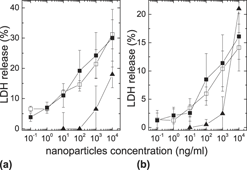Crossref Citations
This article has been cited by the following publications. This list is generated based on data provided by
Crossref.
D’Amato, Rosaria
Falconieri, Mauro
Gagliardi, Serena
Popovici, Ernest
Serra, Emanuele
Terranova, Gaetano
and
Borsella, Elisabetta
2013.
Synthesis of ceramic nanoparticles by laser pyrolysis: From research to applications.
Journal of Analytical and Applied Pyrolysis,
Vol. 104,
Issue. ,
p.
461.
Falconieri, Mauro
Trave, Enrico
D'Amato, Rosaria
and
Borsella, Elisabetta
2013.
Study of defect‐related light emission in oxidized silicon nanocrystals.
physica status solidi (b),
Vol. 250,
Issue. 4,
p.
831.
Dasog, Mita
De los Reyes, Glenda B.
Titova, Lyubov V.
Hegmann, Frank A.
and
Veinot, Jonathan G. C.
2014.
Size vs Surface: Tuning the Photoluminescence of Freestanding Silicon Nanocrystals Across the Visible Spectrum via Surface Groups.
ACS Nano,
Vol. 8,
Issue. 9,
p.
9636.
Pi, Xiaodong
Yu, Ting
and
Yang, Deren
2014.
Water‐Dispersible Silicon‐Quantum‐Dot‐Containing Micelles Self‐Assembled from an Amphiphilic Polymer.
Particle & Particle Systems Characterization,
Vol. 31,
Issue. 7,
p.
751.
Zhai, Yi
Dasog, Mita
Snitynsky, Ryan B.
Purkait, Tapas K.
Aghajamali, Maryam
Hahn, Allison H.
Sturdy, Christopher B.
Lowary, Todd L.
and
Veinot, Jonathan G. C.
2014.
Water-soluble photoluminescent d-mannose and l-alanine functionalized silicon nanocrystals and their application to cancer cell imaging.
J. Mater. Chem. B,
Vol. 2,
Issue. 47,
p.
8427.
Yang, Zhenyu
Gonzalez, Christina M.
Purkait, Tapas K.
Iqbal, Muhammad
Meldrum, Al
and
Veinot, Jonathan G. C.
2015.
Radical Initiated Hydrosilylation on Silicon Nanocrystal Surfaces: An Evaluation of Functional Group Tolerance and Mechanistic Study.
Langmuir,
Vol. 31,
Issue. 38,
p.
10540.
Kocevski, V.
Eriksson, O.
and
Rusz, J.
2015.
Size dependence of the stability, electronic structure, and optical properties of silicon nanocrystals with various surface impurities.
Physical Review B,
Vol. 91,
Issue. 12,
Song, Jun
Qu, Junle
Swihart, Mark T.
and
Prasad, Paras N.
2016.
Near-IR responsive nanostructures for nanobiophotonics: emerging impacts on nanomedicine.
Nanomedicine: Nanotechnology, Biology and Medicine,
Vol. 12,
Issue. 3,
p.
771.
Svrcek, V.
Mariotti, D.
Cvelbar, U.
Filipič, G.
Lozac’h, M.
McDonald, C.
Tayagaki, T.
and
Matsubara, K.
2016.
Environmentally Friendly Processing Technology for Engineering Silicon Nanocrystals in Water with Laser Pulses.
The Journal of Physical Chemistry C,
Vol. 120,
Issue. 33,
p.
18822.
Hemmer, Eva
Benayas, Antonio
Légaré, François
and
Vetrone, Fiorenzo
2016.
Exploiting the biological windows: current perspectives on fluorescent bioprobes emitting above 1000 nm.
Nanoscale Horizons,
Vol. 1,
Issue. 3,
p.
168.
Kocevski, V.
2018.
Temperature dependence of radiative lifetimes, optical and electronic properties of silicon nanocrystals capped with various organic ligands.
The Journal of Chemical Physics,
Vol. 149,
Issue. 5,
Yuan, Ze
Nakamura, Toshihiro
Chinnathambi, Shanmugavel
Pu, Yanbai
Shirahata, Naoto
and
Matsuishi, Kiyoto
2019.
Facile Formation of Stable Water‐Dispersed Luminescent Silicon Nanocrystals by Laser Processing in Liquid: Toward Fluorescent Labeling for Bio‐Imaging.
ChemNanoMat,
Vol. 5,
Issue. 9,
p.
1137.
Bai, Yunfeng
Su, Qian
Xiao, Jimei
Feng, Feng
and
Yang, Xiaoming
2020.
Exploration of synthesizing fluorescent silicon nanoparticles and label-free detection of sulfadiazine sodium.
Talanta,
Vol. 220,
Issue. ,
p.
121410.
Furey, Brandon J.
Stacy, Benjamin J.
Shah, Tushti
Barba-Barba, Rodrigo M.
Carriles, Ramon
Bernal, Alan
Mendoza, Bernardo S.
Korgel, Brian A.
and
Downer, Michael C.
2022.
Two-Photon Excitation Spectroscopy of Silicon Quantum Dots and Ramifications for Bio-Imaging.
ACS Nano,
Vol. 16,
Issue. 4,
p.
6023.
Rahimi, Fatemeh
and
Anbia, Mansoor
2022.
Determination of cyanide based on a dual-emission ratiometric nanoprobe using silver sulfide quantum dots and silicon nanoparticles.
Microchimica Acta,
Vol. 189,
Issue. 3,
Dutt, Ateet
Salinas, Rafael Antonio
Martínez-Tolibia, Shirlley E.
Ramos-Serrano, Juan Ramón
Jain, Manmohan
Hamui, Leon
Ramos, Carlos David
Mostafavi, Ebrahim
Kumar Mishra, Yogendra
Matsumoto, Yasuhiro
Santana, Guillermo
Thakur, Vijay Kumar
and
Kaushik, Ajeet Kumar
2023.
Silicon Compound Nanomaterials: Exploring Emission Mechanisms and Photobiological Applications.
Advanced Photonics Research,
Vol. 4,
Issue. 8,



